Impact of Macroeconomic Policies on the UK Economy: A Review
VerifiedAdded on 2023/06/09
|11
|3639
|317
Report
AI Summary
This report provides a comprehensive overview of macroeconomic policies in the United Kingdom, analyzing their impact on the UK's economic welfare over the past decade. It delves into key aspects such as fiscal and monetary policies, including quantitative easing, and examines their roles in managing inflation, unemployment, and economic growth. The report also discusses specific policies like the Work Bill, Universal Credit, and energy policies, assessing their effects on the UK's economic landscape. Furthermore, it explores demand-side policies and their significance in influencing the economy. By examining these various components, the report offers insights into the UK's economic infrastructure and its influence on society, highlighting the merits and demerits of implemented changes and reforms. The analysis also considers the impact of recent events, such as the pandemic, on the UK's economic performance, providing a well-rounded perspective on the current state and future prospects of the UK economy.
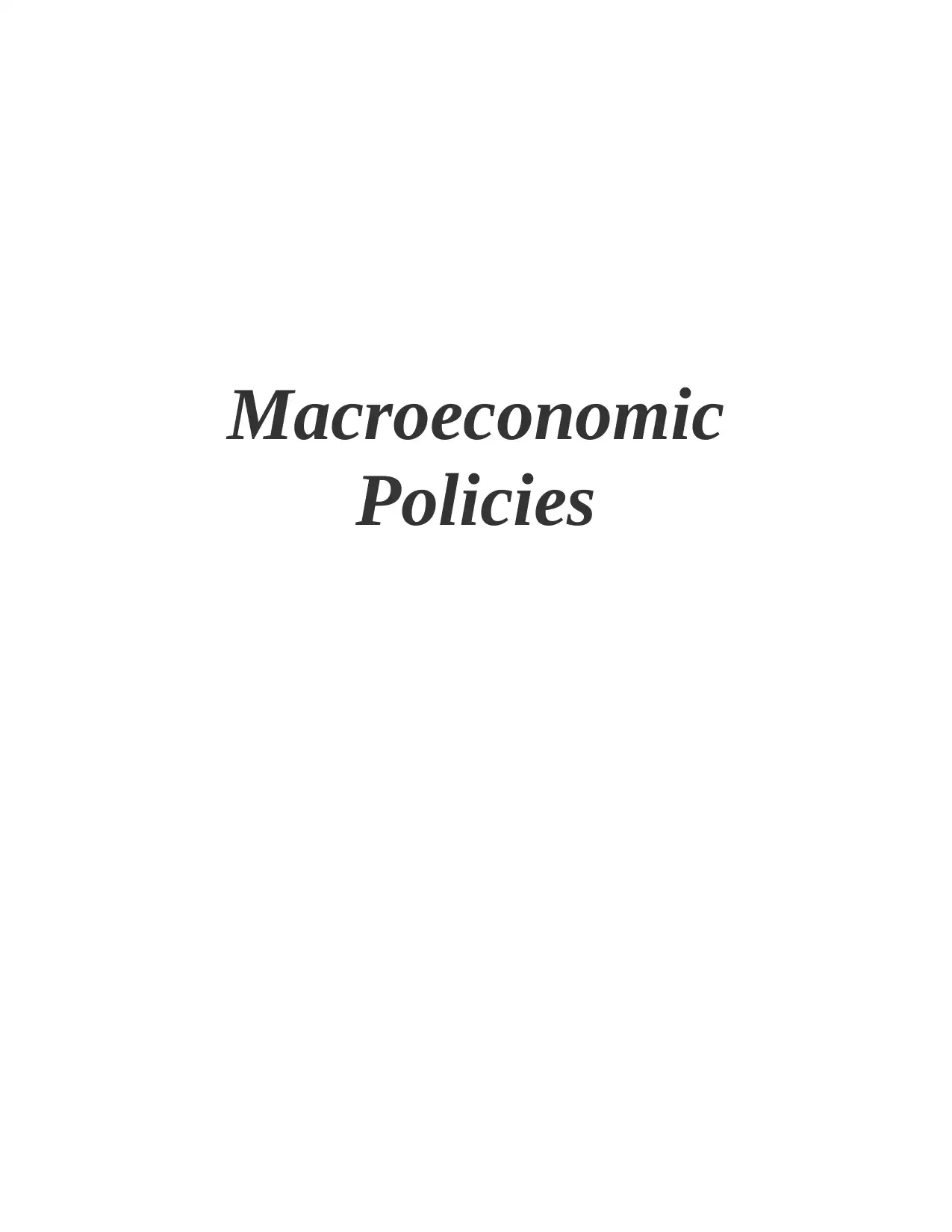
Macroeconomic
Policies
Policies
Paraphrase This Document
Need a fresh take? Get an instant paraphrase of this document with our AI Paraphraser
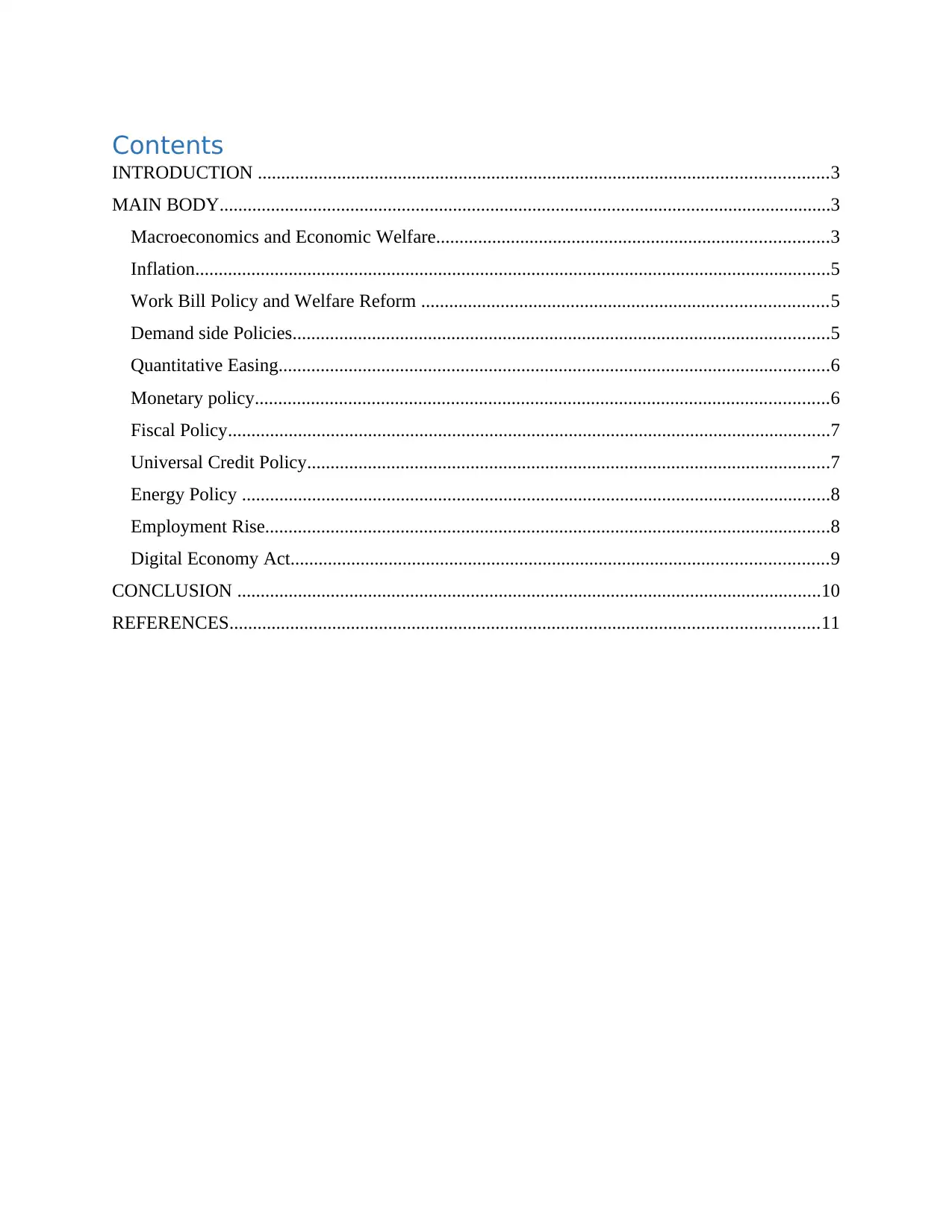
Contents
INTRODUCTION ..........................................................................................................................3
MAIN BODY...................................................................................................................................3
Macroeconomics and Economic Welfare....................................................................................3
Inflation........................................................................................................................................5
Work Bill Policy and Welfare Reform .......................................................................................5
Demand side Policies...................................................................................................................5
Quantitative Easing......................................................................................................................6
Monetary policy...........................................................................................................................6
Fiscal Policy.................................................................................................................................7
Universal Credit Policy................................................................................................................7
Energy Policy ..............................................................................................................................8
Employment Rise.........................................................................................................................8
Digital Economy Act...................................................................................................................9
CONCLUSION .............................................................................................................................10
REFERENCES..............................................................................................................................11
INTRODUCTION ..........................................................................................................................3
MAIN BODY...................................................................................................................................3
Macroeconomics and Economic Welfare....................................................................................3
Inflation........................................................................................................................................5
Work Bill Policy and Welfare Reform .......................................................................................5
Demand side Policies...................................................................................................................5
Quantitative Easing......................................................................................................................6
Monetary policy...........................................................................................................................6
Fiscal Policy.................................................................................................................................7
Universal Credit Policy................................................................................................................7
Energy Policy ..............................................................................................................................8
Employment Rise.........................................................................................................................8
Digital Economy Act...................................................................................................................9
CONCLUSION .............................................................................................................................10
REFERENCES..............................................................................................................................11
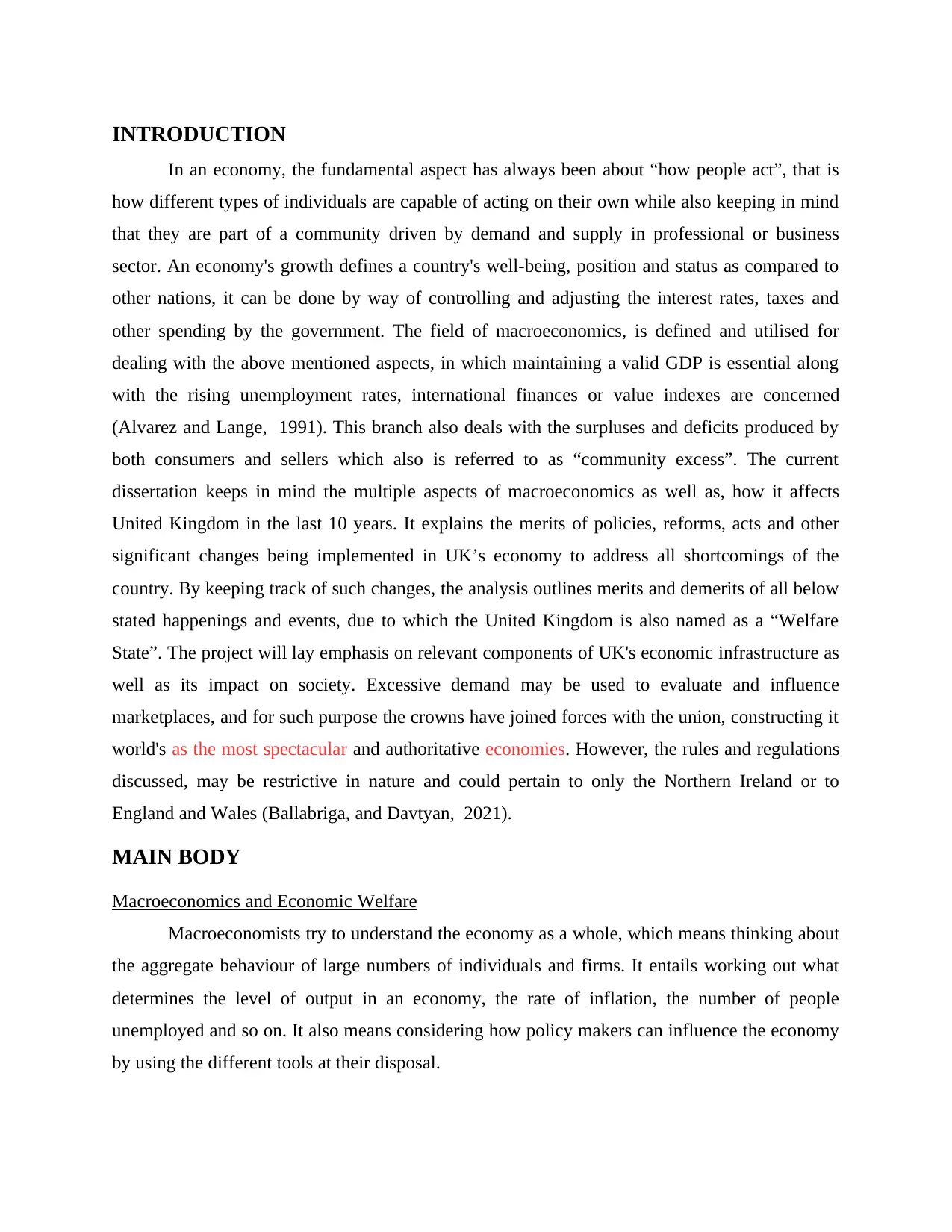
INTRODUCTION
In an economy, the fundamental aspect has always been about “how people act”, that is
how different types of individuals are capable of acting on their own while also keeping in mind
that they are part of a community driven by demand and supply in professional or business
sector. An economy's growth defines a country's well-being, position and status as compared to
other nations, it can be done by way of controlling and adjusting the interest rates, taxes and
other spending by the government. The field of macroeconomics, is defined and utilised for
dealing with the above mentioned aspects, in which maintaining a valid GDP is essential along
with the rising unemployment rates, international finances or value indexes are concerned
(Alvarez and Lange, 1991). This branch also deals with the surpluses and deficits produced by
both consumers and sellers which also is referred to as “community excess”. The current
dissertation keeps in mind the multiple aspects of macroeconomics as well as, how it affects
United Kingdom in the last 10 years. It explains the merits of policies, reforms, acts and other
significant changes being implemented in UK’s economy to address all shortcomings of the
country. By keeping track of such changes, the analysis outlines merits and demerits of all below
stated happenings and events, due to which the United Kingdom is also named as a “Welfare
State”. The project will lay emphasis on relevant components of UK's economic infrastructure as
well as its impact on society. Excessive demand may be used to evaluate and influence
marketplaces, and for such purpose the crowns have joined forces with the union, constructing it
world's as the most spectacular and authoritative economies. However, the rules and regulations
discussed, may be restrictive in nature and could pertain to only the Northern Ireland or to
England and Wales (Ballabriga, and Davtyan, 2021).
MAIN BODY
Macroeconomics and Economic Welfare
Macroeconomists try to understand the economy as a whole, which means thinking about
the aggregate behaviour of large numbers of individuals and firms. It entails working out what
determines the level of output in an economy, the rate of inflation, the number of people
unemployed and so on. It also means considering how policy makers can influence the economy
by using the different tools at their disposal.
In an economy, the fundamental aspect has always been about “how people act”, that is
how different types of individuals are capable of acting on their own while also keeping in mind
that they are part of a community driven by demand and supply in professional or business
sector. An economy's growth defines a country's well-being, position and status as compared to
other nations, it can be done by way of controlling and adjusting the interest rates, taxes and
other spending by the government. The field of macroeconomics, is defined and utilised for
dealing with the above mentioned aspects, in which maintaining a valid GDP is essential along
with the rising unemployment rates, international finances or value indexes are concerned
(Alvarez and Lange, 1991). This branch also deals with the surpluses and deficits produced by
both consumers and sellers which also is referred to as “community excess”. The current
dissertation keeps in mind the multiple aspects of macroeconomics as well as, how it affects
United Kingdom in the last 10 years. It explains the merits of policies, reforms, acts and other
significant changes being implemented in UK’s economy to address all shortcomings of the
country. By keeping track of such changes, the analysis outlines merits and demerits of all below
stated happenings and events, due to which the United Kingdom is also named as a “Welfare
State”. The project will lay emphasis on relevant components of UK's economic infrastructure as
well as its impact on society. Excessive demand may be used to evaluate and influence
marketplaces, and for such purpose the crowns have joined forces with the union, constructing it
world's as the most spectacular and authoritative economies. However, the rules and regulations
discussed, may be restrictive in nature and could pertain to only the Northern Ireland or to
England and Wales (Ballabriga, and Davtyan, 2021).
MAIN BODY
Macroeconomics and Economic Welfare
Macroeconomists try to understand the economy as a whole, which means thinking about
the aggregate behaviour of large numbers of individuals and firms. It entails working out what
determines the level of output in an economy, the rate of inflation, the number of people
unemployed and so on. It also means considering how policy makers can influence the economy
by using the different tools at their disposal.
⊘ This is a preview!⊘
Do you want full access?
Subscribe today to unlock all pages.

Trusted by 1+ million students worldwide
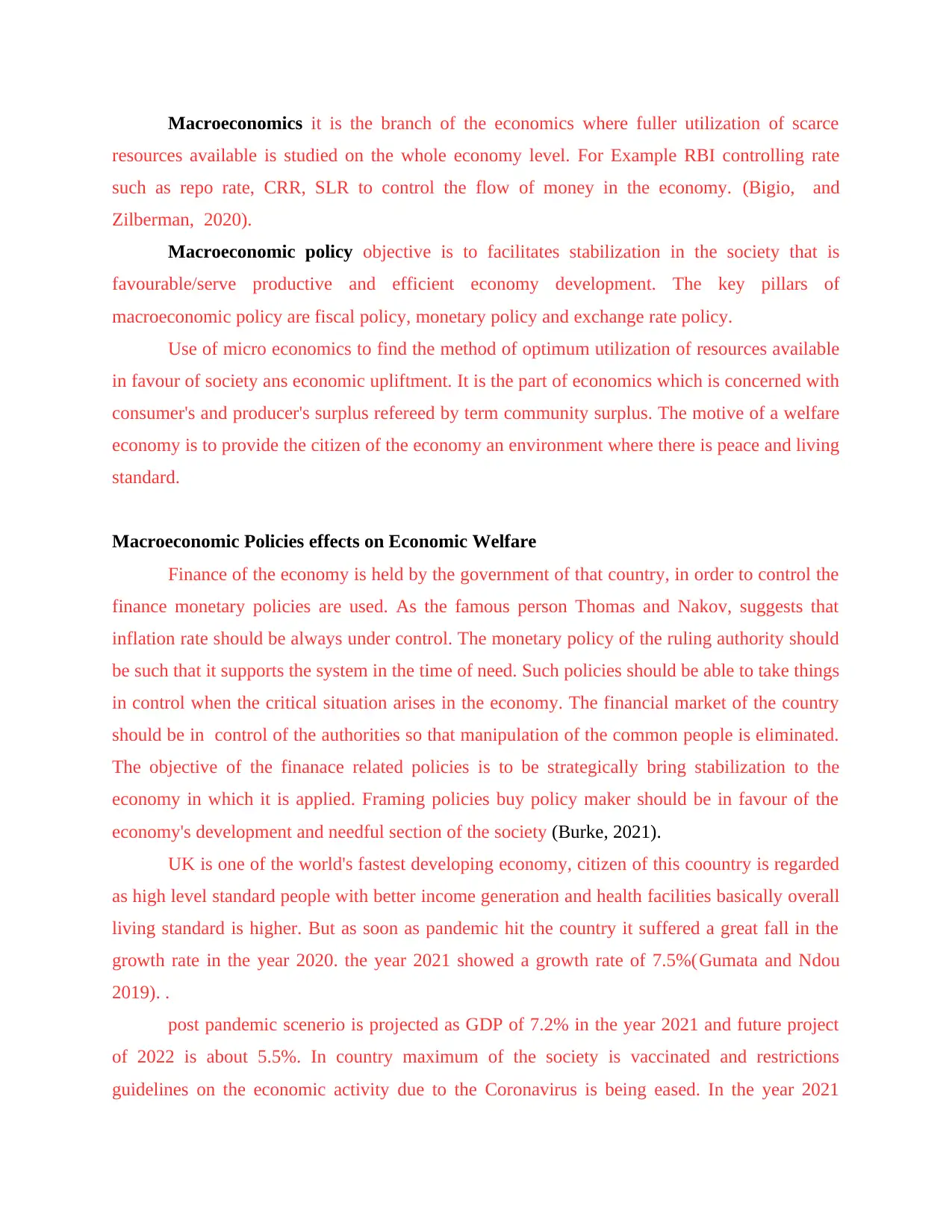
Macroeconomics it is the branch of the economics where fuller utilization of scarce
resources available is studied on the whole economy level. For Example RBI controlling rate
such as repo rate, CRR, SLR to control the flow of money in the economy. (Bigio, and
Zilberman, 2020).
Macroeconomic policy objective is to facilitates stabilization in the society that is
favourable/serve productive and efficient economy development. The key pillars of
macroeconomic policy are fiscal policy, monetary policy and exchange rate policy.
Use of micro economics to find the method of optimum utilization of resources available
in favour of society ans economic upliftment. It is the part of economics which is concerned with
consumer's and producer's surplus refereed by term community surplus. The motive of a welfare
economy is to provide the citizen of the economy an environment where there is peace and living
standard.
Macroeconomic Policies effects on Economic Welfare
Finance of the economy is held by the government of that country, in order to control the
finance monetary policies are used. As the famous person Thomas and Nakov, suggests that
inflation rate should be always under control. The monetary policy of the ruling authority should
be such that it supports the system in the time of need. Such policies should be able to take things
in control when the critical situation arises in the economy. The financial market of the country
should be in control of the authorities so that manipulation of the common people is eliminated.
The objective of the finanace related policies is to be strategically bring stabilization to the
economy in which it is applied. Framing policies buy policy maker should be in favour of the
economy's development and needful section of the society (Burke, 2021).
UK is one of the world's fastest developing economy, citizen of this coountry is regarded
as high level standard people with better income generation and health facilities basically overall
living standard is higher. But as soon as pandemic hit the country it suffered a great fall in the
growth rate in the year 2020. the year 2021 showed a growth rate of 7.5%(Gumata and Ndou
2019). .
post pandemic scenerio is projected as GDP of 7.2% in the year 2021 and future project
of 2022 is about 5.5%. In country maximum of the society is vaccinated and restrictions
guidelines on the economic activity due to the Coronavirus is being eased. In the year 2021
resources available is studied on the whole economy level. For Example RBI controlling rate
such as repo rate, CRR, SLR to control the flow of money in the economy. (Bigio, and
Zilberman, 2020).
Macroeconomic policy objective is to facilitates stabilization in the society that is
favourable/serve productive and efficient economy development. The key pillars of
macroeconomic policy are fiscal policy, monetary policy and exchange rate policy.
Use of micro economics to find the method of optimum utilization of resources available
in favour of society ans economic upliftment. It is the part of economics which is concerned with
consumer's and producer's surplus refereed by term community surplus. The motive of a welfare
economy is to provide the citizen of the economy an environment where there is peace and living
standard.
Macroeconomic Policies effects on Economic Welfare
Finance of the economy is held by the government of that country, in order to control the
finance monetary policies are used. As the famous person Thomas and Nakov, suggests that
inflation rate should be always under control. The monetary policy of the ruling authority should
be such that it supports the system in the time of need. Such policies should be able to take things
in control when the critical situation arises in the economy. The financial market of the country
should be in control of the authorities so that manipulation of the common people is eliminated.
The objective of the finanace related policies is to be strategically bring stabilization to the
economy in which it is applied. Framing policies buy policy maker should be in favour of the
economy's development and needful section of the society (Burke, 2021).
UK is one of the world's fastest developing economy, citizen of this coountry is regarded
as high level standard people with better income generation and health facilities basically overall
living standard is higher. But as soon as pandemic hit the country it suffered a great fall in the
growth rate in the year 2020. the year 2021 showed a growth rate of 7.5%(Gumata and Ndou
2019). .
post pandemic scenerio is projected as GDP of 7.2% in the year 2021 and future project
of 2022 is about 5.5%. In country maximum of the society is vaccinated and restrictions
guidelines on the economic activity due to the Coronavirus is being eased. In the year 2021
Paraphrase This Document
Need a fresh take? Get an instant paraphrase of this document with our AI Paraphraser
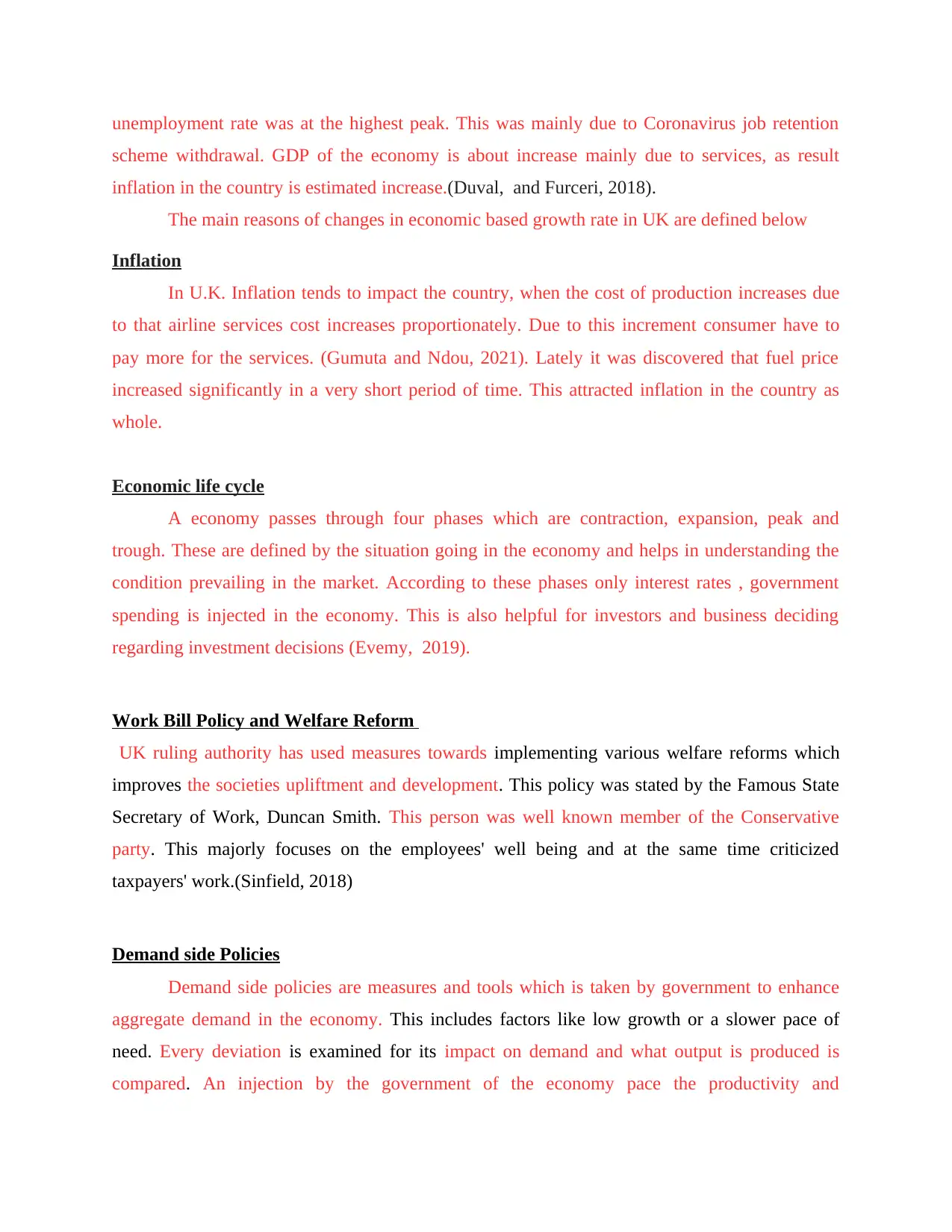
unemployment rate was at the highest peak. This was mainly due to Coronavirus job retention
scheme withdrawal. GDP of the economy is about increase mainly due to services, as result
inflation in the country is estimated increase.(Duval, and Furceri, 2018).
The main reasons of changes in economic based growth rate in UK are defined below
Inflation
In U.K. Inflation tends to impact the country, when the cost of production increases due
to that airline services cost increases proportionately. Due to this increment consumer have to
pay more for the services. (Gumuta and Ndou, 2021). Lately it was discovered that fuel price
increased significantly in a very short period of time. This attracted inflation in the country as
whole.
Economic life cycle
A economy passes through four phases which are contraction, expansion, peak and
trough. These are defined by the situation going in the economy and helps in understanding the
condition prevailing in the market. According to these phases only interest rates , government
spending is injected in the economy. This is also helpful for investors and business deciding
regarding investment decisions (Evemy, 2019).
Work Bill Policy and Welfare Reform
UK ruling authority has used measures towards implementing various welfare reforms which
improves the societies upliftment and development. This policy was stated by the Famous State
Secretary of Work, Duncan Smith. This person was well known member of the Conservative
party. This majorly focuses on the employees' well being and at the same time criticized
taxpayers' work.(Sinfield, 2018)
Demand side Policies
Demand side policies are measures and tools which is taken by government to enhance
aggregate demand in the economy. This includes factors like low growth or a slower pace of
need. Every deviation is examined for its impact on demand and what output is produced is
compared. An injection by the government of the economy pace the productivity and
scheme withdrawal. GDP of the economy is about increase mainly due to services, as result
inflation in the country is estimated increase.(Duval, and Furceri, 2018).
The main reasons of changes in economic based growth rate in UK are defined below
Inflation
In U.K. Inflation tends to impact the country, when the cost of production increases due
to that airline services cost increases proportionately. Due to this increment consumer have to
pay more for the services. (Gumuta and Ndou, 2021). Lately it was discovered that fuel price
increased significantly in a very short period of time. This attracted inflation in the country as
whole.
Economic life cycle
A economy passes through four phases which are contraction, expansion, peak and
trough. These are defined by the situation going in the economy and helps in understanding the
condition prevailing in the market. According to these phases only interest rates , government
spending is injected in the economy. This is also helpful for investors and business deciding
regarding investment decisions (Evemy, 2019).
Work Bill Policy and Welfare Reform
UK ruling authority has used measures towards implementing various welfare reforms which
improves the societies upliftment and development. This policy was stated by the Famous State
Secretary of Work, Duncan Smith. This person was well known member of the Conservative
party. This majorly focuses on the employees' well being and at the same time criticized
taxpayers' work.(Sinfield, 2018)
Demand side Policies
Demand side policies are measures and tools which is taken by government to enhance
aggregate demand in the economy. This includes factors like low growth or a slower pace of
need. Every deviation is examined for its impact on demand and what output is produced is
compared. An injection by the government of the economy pace the productivity and
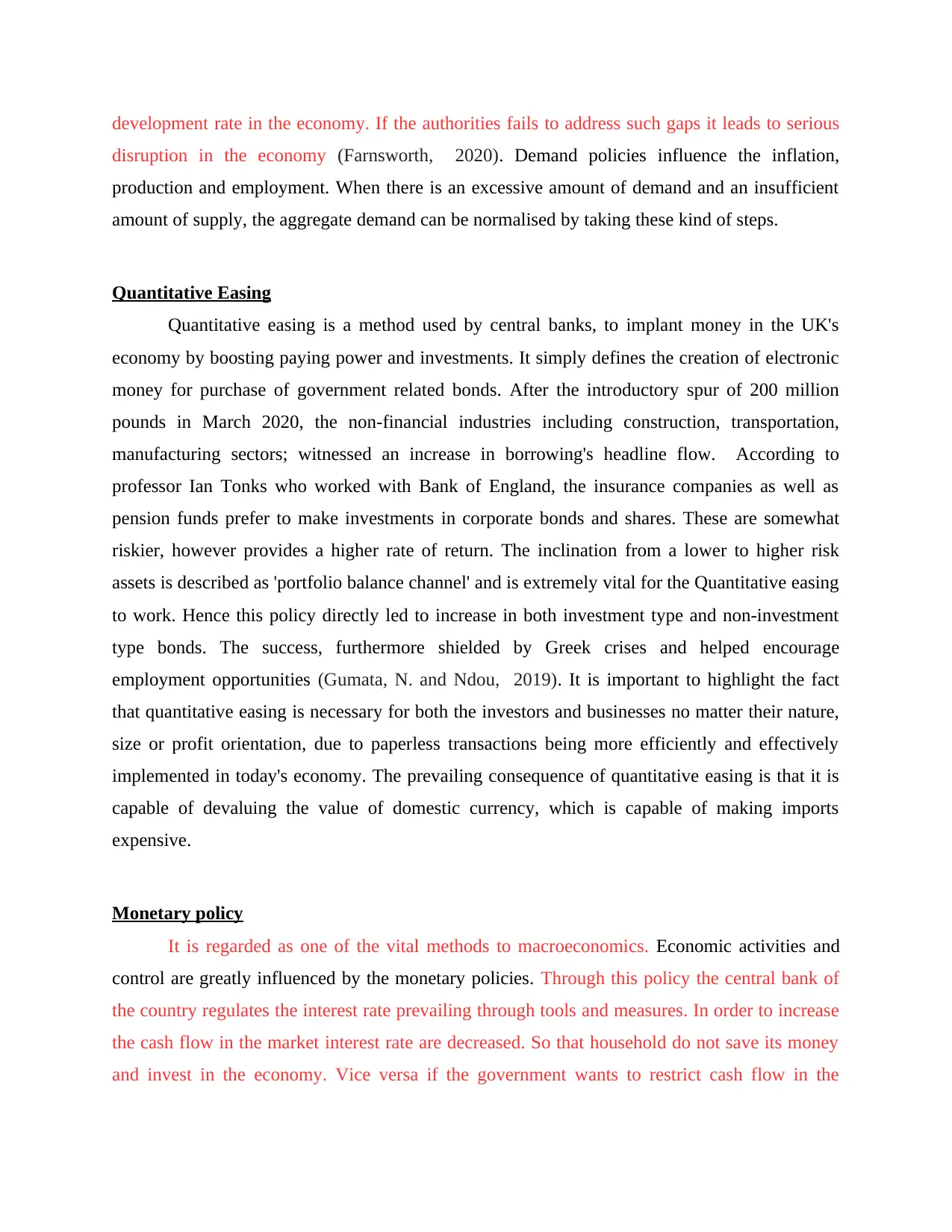
development rate in the economy. If the authorities fails to address such gaps it leads to serious
disruption in the economy (Farnsworth, 2020). Demand policies influence the inflation,
production and employment. When there is an excessive amount of demand and an insufficient
amount of supply, the aggregate demand can be normalised by taking these kind of steps.
Quantitative Easing
Quantitative easing is a method used by central banks, to implant money in the UK's
economy by boosting paying power and investments. It simply defines the creation of electronic
money for purchase of government related bonds. After the introductory spur of 200 million
pounds in March 2020, the non-financial industries including construction, transportation,
manufacturing sectors; witnessed an increase in borrowing's headline flow. According to
professor Ian Tonks who worked with Bank of England, the insurance companies as well as
pension funds prefer to make investments in corporate bonds and shares. These are somewhat
riskier, however provides a higher rate of return. The inclination from a lower to higher risk
assets is described as 'portfolio balance channel' and is extremely vital for the Quantitative easing
to work. Hence this policy directly led to increase in both investment type and non-investment
type bonds. The success, furthermore shielded by Greek crises and helped encourage
employment opportunities (Gumata, N. and Ndou, 2019). It is important to highlight the fact
that quantitative easing is necessary for both the investors and businesses no matter their nature,
size or profit orientation, due to paperless transactions being more efficiently and effectively
implemented in today's economy. The prevailing consequence of quantitative easing is that it is
capable of devaluing the value of domestic currency, which is capable of making imports
expensive.
Monetary policy
It is regarded as one of the vital methods to macroeconomics. Economic activities and
control are greatly influenced by the monetary policies. Through this policy the central bank of
the country regulates the interest rate prevailing through tools and measures. In order to increase
the cash flow in the market interest rate are decreased. So that household do not save its money
and invest in the economy. Vice versa if the government wants to restrict cash flow in the
disruption in the economy (Farnsworth, 2020). Demand policies influence the inflation,
production and employment. When there is an excessive amount of demand and an insufficient
amount of supply, the aggregate demand can be normalised by taking these kind of steps.
Quantitative Easing
Quantitative easing is a method used by central banks, to implant money in the UK's
economy by boosting paying power and investments. It simply defines the creation of electronic
money for purchase of government related bonds. After the introductory spur of 200 million
pounds in March 2020, the non-financial industries including construction, transportation,
manufacturing sectors; witnessed an increase in borrowing's headline flow. According to
professor Ian Tonks who worked with Bank of England, the insurance companies as well as
pension funds prefer to make investments in corporate bonds and shares. These are somewhat
riskier, however provides a higher rate of return. The inclination from a lower to higher risk
assets is described as 'portfolio balance channel' and is extremely vital for the Quantitative easing
to work. Hence this policy directly led to increase in both investment type and non-investment
type bonds. The success, furthermore shielded by Greek crises and helped encourage
employment opportunities (Gumata, N. and Ndou, 2019). It is important to highlight the fact
that quantitative easing is necessary for both the investors and businesses no matter their nature,
size or profit orientation, due to paperless transactions being more efficiently and effectively
implemented in today's economy. The prevailing consequence of quantitative easing is that it is
capable of devaluing the value of domestic currency, which is capable of making imports
expensive.
Monetary policy
It is regarded as one of the vital methods to macroeconomics. Economic activities and
control are greatly influenced by the monetary policies. Through this policy the central bank of
the country regulates the interest rate prevailing through tools and measures. In order to increase
the cash flow in the market interest rate are decreased. So that household do not save its money
and invest in the economy. Vice versa if the government wants to restrict cash flow in the
⊘ This is a preview!⊘
Do you want full access?
Subscribe today to unlock all pages.

Trusted by 1+ million students worldwide
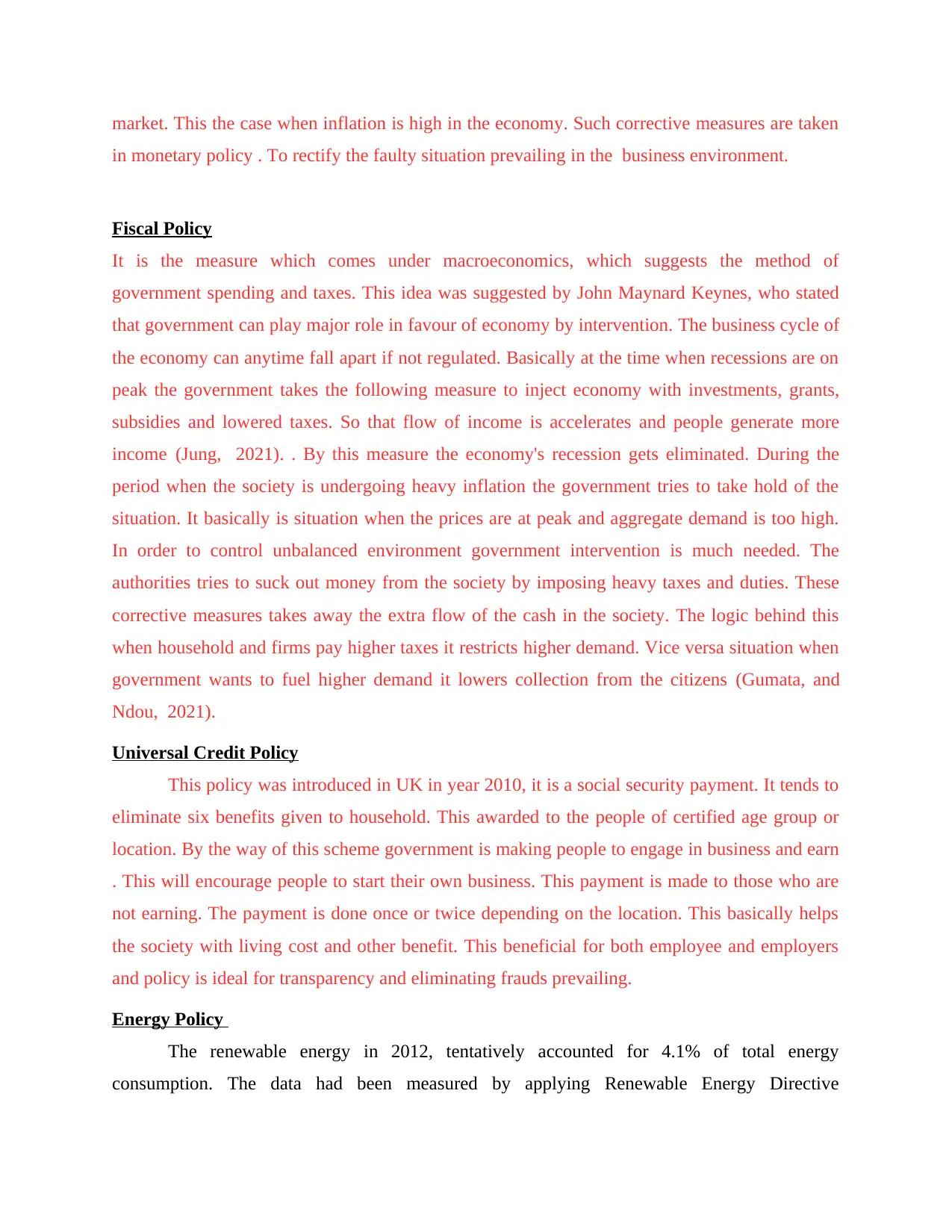
market. This the case when inflation is high in the economy. Such corrective measures are taken
in monetary policy . To rectify the faulty situation prevailing in the business environment.
Fiscal Policy
It is the measure which comes under macroeconomics, which suggests the method of
government spending and taxes. This idea was suggested by John Maynard Keynes, who stated
that government can play major role in favour of economy by intervention. The business cycle of
the economy can anytime fall apart if not regulated. Basically at the time when recessions are on
peak the government takes the following measure to inject economy with investments, grants,
subsidies and lowered taxes. So that flow of income is accelerates and people generate more
income (Jung, 2021). . By this measure the economy's recession gets eliminated. During the
period when the society is undergoing heavy inflation the government tries to take hold of the
situation. It basically is situation when the prices are at peak and aggregate demand is too high.
In order to control unbalanced environment government intervention is much needed. The
authorities tries to suck out money from the society by imposing heavy taxes and duties. These
corrective measures takes away the extra flow of the cash in the society. The logic behind this
when household and firms pay higher taxes it restricts higher demand. Vice versa situation when
government wants to fuel higher demand it lowers collection from the citizens (Gumata, and
Ndou, 2021).
Universal Credit Policy
This policy was introduced in UK in year 2010, it is a social security payment. It tends to
eliminate six benefits given to household. This awarded to the people of certified age group or
location. By the way of this scheme government is making people to engage in business and earn
. This will encourage people to start their own business. This payment is made to those who are
not earning. The payment is done once or twice depending on the location. This basically helps
the society with living cost and other benefit. This beneficial for both employee and employers
and policy is ideal for transparency and eliminating frauds prevailing.
Energy Policy
The renewable energy in 2012, tentatively accounted for 4.1% of total energy
consumption. The data had been measured by applying Renewable Energy Directive
in monetary policy . To rectify the faulty situation prevailing in the business environment.
Fiscal Policy
It is the measure which comes under macroeconomics, which suggests the method of
government spending and taxes. This idea was suggested by John Maynard Keynes, who stated
that government can play major role in favour of economy by intervention. The business cycle of
the economy can anytime fall apart if not regulated. Basically at the time when recessions are on
peak the government takes the following measure to inject economy with investments, grants,
subsidies and lowered taxes. So that flow of income is accelerates and people generate more
income (Jung, 2021). . By this measure the economy's recession gets eliminated. During the
period when the society is undergoing heavy inflation the government tries to take hold of the
situation. It basically is situation when the prices are at peak and aggregate demand is too high.
In order to control unbalanced environment government intervention is much needed. The
authorities tries to suck out money from the society by imposing heavy taxes and duties. These
corrective measures takes away the extra flow of the cash in the society. The logic behind this
when household and firms pay higher taxes it restricts higher demand. Vice versa situation when
government wants to fuel higher demand it lowers collection from the citizens (Gumata, and
Ndou, 2021).
Universal Credit Policy
This policy was introduced in UK in year 2010, it is a social security payment. It tends to
eliminate six benefits given to household. This awarded to the people of certified age group or
location. By the way of this scheme government is making people to engage in business and earn
. This will encourage people to start their own business. This payment is made to those who are
not earning. The payment is done once or twice depending on the location. This basically helps
the society with living cost and other benefit. This beneficial for both employee and employers
and policy is ideal for transparency and eliminating frauds prevailing.
Energy Policy
The renewable energy in 2012, tentatively accounted for 4.1% of total energy
consumption. The data had been measured by applying Renewable Energy Directive
Paraphrase This Document
Need a fresh take? Get an instant paraphrase of this document with our AI Paraphraser
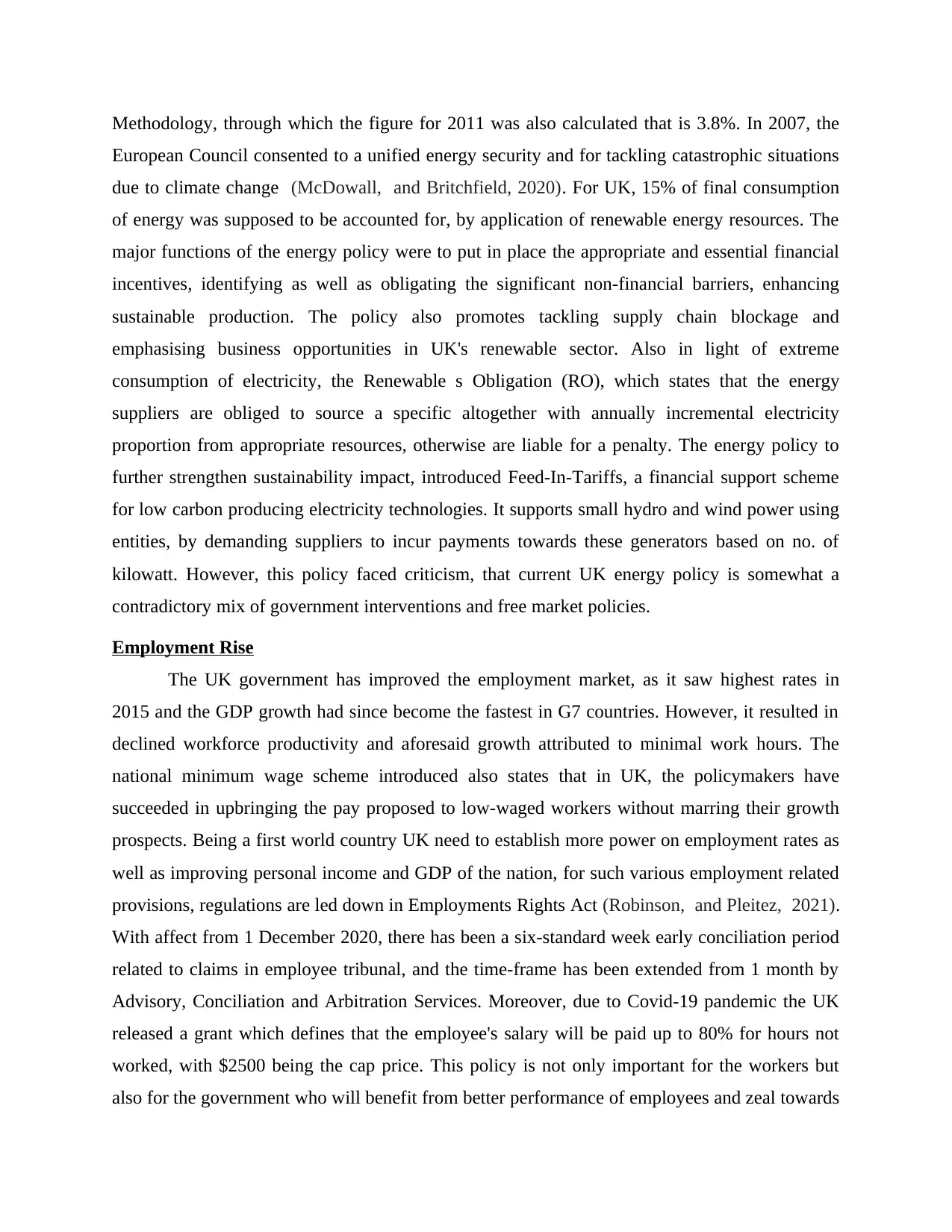
Methodology, through which the figure for 2011 was also calculated that is 3.8%. In 2007, the
European Council consented to a unified energy security and for tackling catastrophic situations
due to climate change (McDowall, and Britchfield, 2020). For UK, 15% of final consumption
of energy was supposed to be accounted for, by application of renewable energy resources. The
major functions of the energy policy were to put in place the appropriate and essential financial
incentives, identifying as well as obligating the significant non-financial barriers, enhancing
sustainable production. The policy also promotes tackling supply chain blockage and
emphasising business opportunities in UK's renewable sector. Also in light of extreme
consumption of electricity, the Renewable s Obligation (RO), which states that the energy
suppliers are obliged to source a specific altogether with annually incremental electricity
proportion from appropriate resources, otherwise are liable for a penalty. The energy policy to
further strengthen sustainability impact, introduced Feed-In-Tariffs, a financial support scheme
for low carbon producing electricity technologies. It supports small hydro and wind power using
entities, by demanding suppliers to incur payments towards these generators based on no. of
kilowatt. However, this policy faced criticism, that current UK energy policy is somewhat a
contradictory mix of government interventions and free market policies.
Employment Rise
The UK government has improved the employment market, as it saw highest rates in
2015 and the GDP growth had since become the fastest in G7 countries. However, it resulted in
declined workforce productivity and aforesaid growth attributed to minimal work hours. The
national minimum wage scheme introduced also states that in UK, the policymakers have
succeeded in upbringing the pay proposed to low-waged workers without marring their growth
prospects. Being a first world country UK need to establish more power on employment rates as
well as improving personal income and GDP of the nation, for such various employment related
provisions, regulations are led down in Employments Rights Act (Robinson, and Pleitez, 2021).
With affect from 1 December 2020, there has been a six-standard week early conciliation period
related to claims in employee tribunal, and the time-frame has been extended from 1 month by
Advisory, Conciliation and Arbitration Services. Moreover, due to Covid-19 pandemic the UK
released a grant which defines that the employee's salary will be paid up to 80% for hours not
worked, with $2500 being the cap price. This policy is not only important for the workers but
also for the government who will benefit from better performance of employees and zeal towards
European Council consented to a unified energy security and for tackling catastrophic situations
due to climate change (McDowall, and Britchfield, 2020). For UK, 15% of final consumption
of energy was supposed to be accounted for, by application of renewable energy resources. The
major functions of the energy policy were to put in place the appropriate and essential financial
incentives, identifying as well as obligating the significant non-financial barriers, enhancing
sustainable production. The policy also promotes tackling supply chain blockage and
emphasising business opportunities in UK's renewable sector. Also in light of extreme
consumption of electricity, the Renewable s Obligation (RO), which states that the energy
suppliers are obliged to source a specific altogether with annually incremental electricity
proportion from appropriate resources, otherwise are liable for a penalty. The energy policy to
further strengthen sustainability impact, introduced Feed-In-Tariffs, a financial support scheme
for low carbon producing electricity technologies. It supports small hydro and wind power using
entities, by demanding suppliers to incur payments towards these generators based on no. of
kilowatt. However, this policy faced criticism, that current UK energy policy is somewhat a
contradictory mix of government interventions and free market policies.
Employment Rise
The UK government has improved the employment market, as it saw highest rates in
2015 and the GDP growth had since become the fastest in G7 countries. However, it resulted in
declined workforce productivity and aforesaid growth attributed to minimal work hours. The
national minimum wage scheme introduced also states that in UK, the policymakers have
succeeded in upbringing the pay proposed to low-waged workers without marring their growth
prospects. Being a first world country UK need to establish more power on employment rates as
well as improving personal income and GDP of the nation, for such various employment related
provisions, regulations are led down in Employments Rights Act (Robinson, and Pleitez, 2021).
With affect from 1 December 2020, there has been a six-standard week early conciliation period
related to claims in employee tribunal, and the time-frame has been extended from 1 month by
Advisory, Conciliation and Arbitration Services. Moreover, due to Covid-19 pandemic the UK
released a grant which defines that the employee's salary will be paid up to 80% for hours not
worked, with $2500 being the cap price. This policy is not only important for the workers but
also for the government who will benefit from better performance of employees and zeal towards
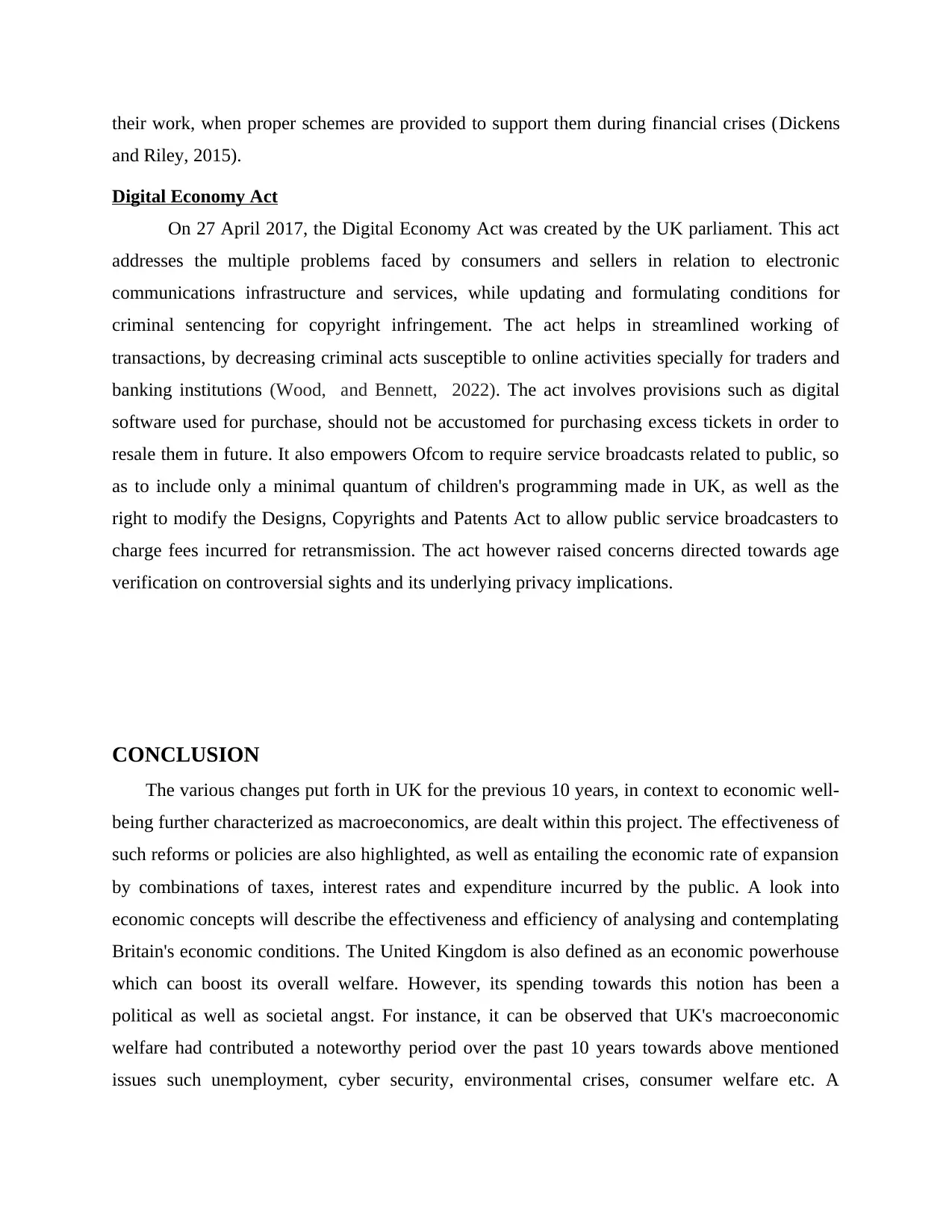
their work, when proper schemes are provided to support them during financial crises (Dickens
and Riley, 2015).
Digital Economy Act
On 27 April 2017, the Digital Economy Act was created by the UK parliament. This act
addresses the multiple problems faced by consumers and sellers in relation to electronic
communications infrastructure and services, while updating and formulating conditions for
criminal sentencing for copyright infringement. The act helps in streamlined working of
transactions, by decreasing criminal acts susceptible to online activities specially for traders and
banking institutions (Wood, and Bennett, 2022). The act involves provisions such as digital
software used for purchase, should not be accustomed for purchasing excess tickets in order to
resale them in future. It also empowers Ofcom to require service broadcasts related to public, so
as to include only a minimal quantum of children's programming made in UK, as well as the
right to modify the Designs, Copyrights and Patents Act to allow public service broadcasters to
charge fees incurred for retransmission. The act however raised concerns directed towards age
verification on controversial sights and its underlying privacy implications.
CONCLUSION
The various changes put forth in UK for the previous 10 years, in context to economic well-
being further characterized as macroeconomics, are dealt within this project. The effectiveness of
such reforms or policies are also highlighted, as well as entailing the economic rate of expansion
by combinations of taxes, interest rates and expenditure incurred by the public. A look into
economic concepts will describe the effectiveness and efficiency of analysing and contemplating
Britain's economic conditions. The United Kingdom is also defined as an economic powerhouse
which can boost its overall welfare. However, its spending towards this notion has been a
political as well as societal angst. For instance, it can be observed that UK's macroeconomic
welfare had contributed a noteworthy period over the past 10 years towards above mentioned
issues such unemployment, cyber security, environmental crises, consumer welfare etc. A
and Riley, 2015).
Digital Economy Act
On 27 April 2017, the Digital Economy Act was created by the UK parliament. This act
addresses the multiple problems faced by consumers and sellers in relation to electronic
communications infrastructure and services, while updating and formulating conditions for
criminal sentencing for copyright infringement. The act helps in streamlined working of
transactions, by decreasing criminal acts susceptible to online activities specially for traders and
banking institutions (Wood, and Bennett, 2022). The act involves provisions such as digital
software used for purchase, should not be accustomed for purchasing excess tickets in order to
resale them in future. It also empowers Ofcom to require service broadcasts related to public, so
as to include only a minimal quantum of children's programming made in UK, as well as the
right to modify the Designs, Copyrights and Patents Act to allow public service broadcasters to
charge fees incurred for retransmission. The act however raised concerns directed towards age
verification on controversial sights and its underlying privacy implications.
CONCLUSION
The various changes put forth in UK for the previous 10 years, in context to economic well-
being further characterized as macroeconomics, are dealt within this project. The effectiveness of
such reforms or policies are also highlighted, as well as entailing the economic rate of expansion
by combinations of taxes, interest rates and expenditure incurred by the public. A look into
economic concepts will describe the effectiveness and efficiency of analysing and contemplating
Britain's economic conditions. The United Kingdom is also defined as an economic powerhouse
which can boost its overall welfare. However, its spending towards this notion has been a
political as well as societal angst. For instance, it can be observed that UK's macroeconomic
welfare had contributed a noteworthy period over the past 10 years towards above mentioned
issues such unemployment, cyber security, environmental crises, consumer welfare etc. A
⊘ This is a preview!⊘
Do you want full access?
Subscribe today to unlock all pages.

Trusted by 1+ million students worldwide
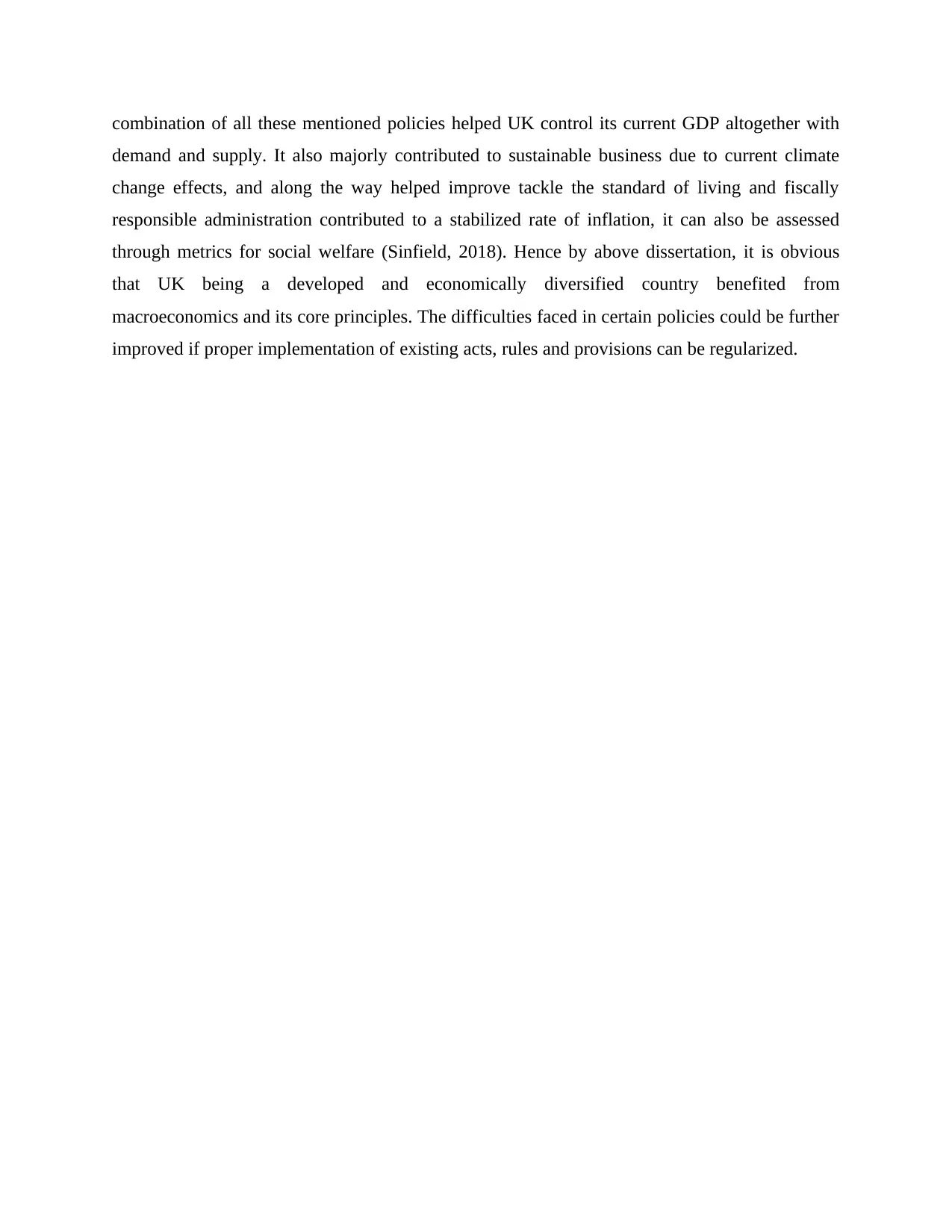
combination of all these mentioned policies helped UK control its current GDP altogether with
demand and supply. It also majorly contributed to sustainable business due to current climate
change effects, and along the way helped improve tackle the standard of living and fiscally
responsible administration contributed to a stabilized rate of inflation, it can also be assessed
through metrics for social welfare (Sinfield, 2018). Hence by above dissertation, it is obvious
that UK being a developed and economically diversified country benefited from
macroeconomics and its core principles. The difficulties faced in certain policies could be further
improved if proper implementation of existing acts, rules and provisions can be regularized.
demand and supply. It also majorly contributed to sustainable business due to current climate
change effects, and along the way helped improve tackle the standard of living and fiscally
responsible administration contributed to a stabilized rate of inflation, it can also be assessed
through metrics for social welfare (Sinfield, 2018). Hence by above dissertation, it is obvious
that UK being a developed and economically diversified country benefited from
macroeconomics and its core principles. The difficulties faced in certain policies could be further
improved if proper implementation of existing acts, rules and provisions can be regularized.
Paraphrase This Document
Need a fresh take? Get an instant paraphrase of this document with our AI Paraphraser
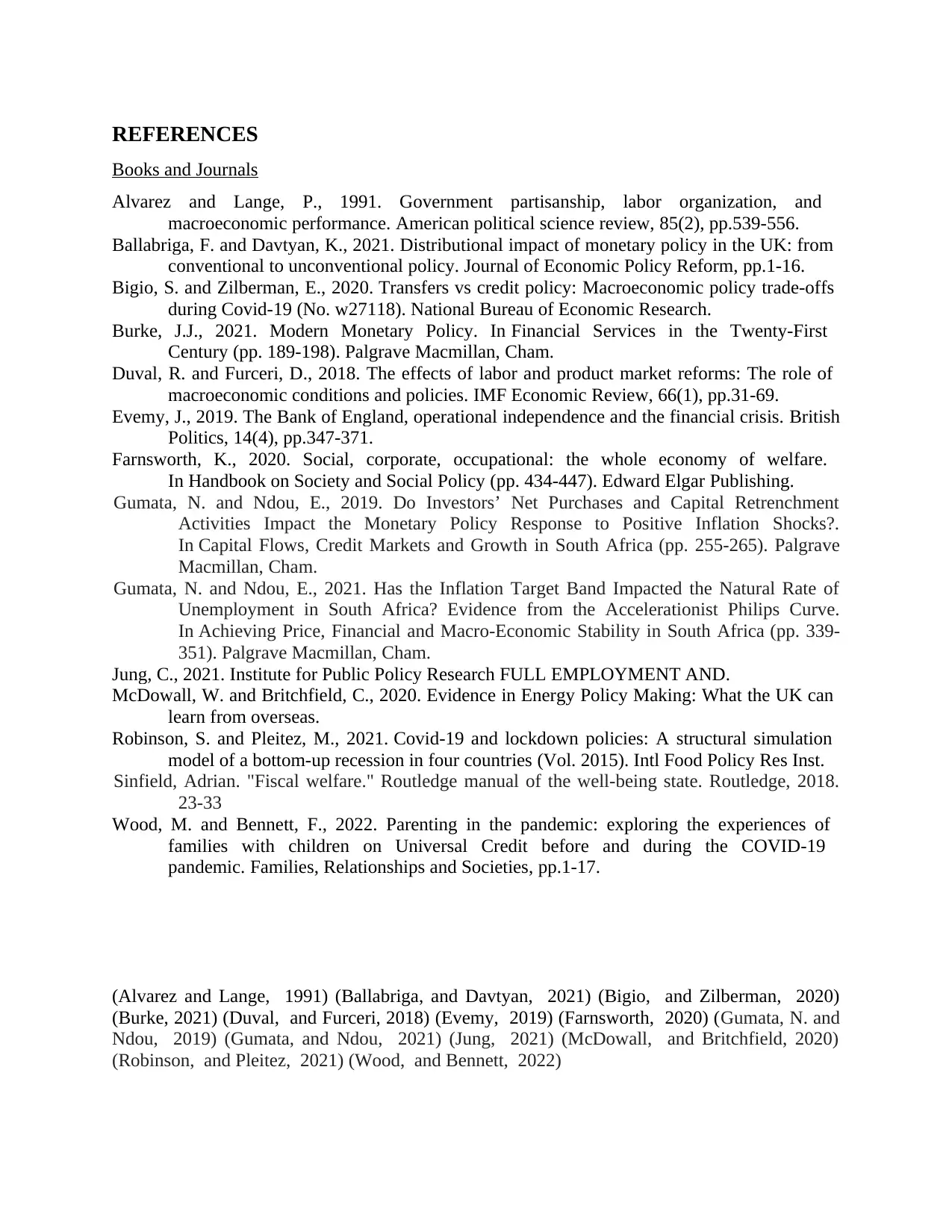
REFERENCES
Books and Journals
Alvarez and Lange, P., 1991. Government partisanship, labor organization, and
macroeconomic performance. American political science review, 85(2), pp.539-556.
Ballabriga, F. and Davtyan, K., 2021. Distributional impact of monetary policy in the UK: from
conventional to unconventional policy. Journal of Economic Policy Reform, pp.1-16.
Bigio, S. and Zilberman, E., 2020. Transfers vs credit policy: Macroeconomic policy trade-offs
during Covid-19 (No. w27118). National Bureau of Economic Research.
Burke, J.J., 2021. Modern Monetary Policy. In Financial Services in the Twenty-First
Century (pp. 189-198). Palgrave Macmillan, Cham.
Duval, R. and Furceri, D., 2018. The effects of labor and product market reforms: The role of
macroeconomic conditions and policies. IMF Economic Review, 66(1), pp.31-69.
Evemy, J., 2019. The Bank of England, operational independence and the financial crisis. British
Politics, 14(4), pp.347-371.
Farnsworth, K., 2020. Social, corporate, occupational: the whole economy of welfare.
In Handbook on Society and Social Policy (pp. 434-447). Edward Elgar Publishing.
Gumata, N. and Ndou, E., 2019. Do Investors’ Net Purchases and Capital Retrenchment
Activities Impact the Monetary Policy Response to Positive Inflation Shocks?.
In Capital Flows, Credit Markets and Growth in South Africa (pp. 255-265). Palgrave
Macmillan, Cham.
Gumata, N. and Ndou, E., 2021. Has the Inflation Target Band Impacted the Natural Rate of
Unemployment in South Africa? Evidence from the Accelerationist Philips Curve.
In Achieving Price, Financial and Macro-Economic Stability in South Africa (pp. 339-
351). Palgrave Macmillan, Cham.
Jung, C., 2021. Institute for Public Policy Research FULL EMPLOYMENT AND.
McDowall, W. and Britchfield, C., 2020. Evidence in Energy Policy Making: What the UK can
learn from overseas.
Robinson, S. and Pleitez, M., 2021. Covid-19 and lockdown policies: A structural simulation
model of a bottom-up recession in four countries (Vol. 2015). Intl Food Policy Res Inst.
Sinfield, Adrian. "Fiscal welfare." Routledge manual of the well-being state. Routledge, 2018.
23-33
Wood, M. and Bennett, F., 2022. Parenting in the pandemic: exploring the experiences of
families with children on Universal Credit before and during the COVID-19
pandemic. Families, Relationships and Societies, pp.1-17.
(Alvarez and Lange, 1991) (Ballabriga, and Davtyan, 2021) (Bigio, and Zilberman, 2020)
(Burke, 2021) (Duval, and Furceri, 2018) (Evemy, 2019) (Farnsworth, 2020) (Gumata, N. and
Ndou, 2019) (Gumata, and Ndou, 2021) (Jung, 2021) (McDowall, and Britchfield, 2020)
(Robinson, and Pleitez, 2021) (Wood, and Bennett, 2022)
Books and Journals
Alvarez and Lange, P., 1991. Government partisanship, labor organization, and
macroeconomic performance. American political science review, 85(2), pp.539-556.
Ballabriga, F. and Davtyan, K., 2021. Distributional impact of monetary policy in the UK: from
conventional to unconventional policy. Journal of Economic Policy Reform, pp.1-16.
Bigio, S. and Zilberman, E., 2020. Transfers vs credit policy: Macroeconomic policy trade-offs
during Covid-19 (No. w27118). National Bureau of Economic Research.
Burke, J.J., 2021. Modern Monetary Policy. In Financial Services in the Twenty-First
Century (pp. 189-198). Palgrave Macmillan, Cham.
Duval, R. and Furceri, D., 2018. The effects of labor and product market reforms: The role of
macroeconomic conditions and policies. IMF Economic Review, 66(1), pp.31-69.
Evemy, J., 2019. The Bank of England, operational independence and the financial crisis. British
Politics, 14(4), pp.347-371.
Farnsworth, K., 2020. Social, corporate, occupational: the whole economy of welfare.
In Handbook on Society and Social Policy (pp. 434-447). Edward Elgar Publishing.
Gumata, N. and Ndou, E., 2019. Do Investors’ Net Purchases and Capital Retrenchment
Activities Impact the Monetary Policy Response to Positive Inflation Shocks?.
In Capital Flows, Credit Markets and Growth in South Africa (pp. 255-265). Palgrave
Macmillan, Cham.
Gumata, N. and Ndou, E., 2021. Has the Inflation Target Band Impacted the Natural Rate of
Unemployment in South Africa? Evidence from the Accelerationist Philips Curve.
In Achieving Price, Financial and Macro-Economic Stability in South Africa (pp. 339-
351). Palgrave Macmillan, Cham.
Jung, C., 2021. Institute for Public Policy Research FULL EMPLOYMENT AND.
McDowall, W. and Britchfield, C., 2020. Evidence in Energy Policy Making: What the UK can
learn from overseas.
Robinson, S. and Pleitez, M., 2021. Covid-19 and lockdown policies: A structural simulation
model of a bottom-up recession in four countries (Vol. 2015). Intl Food Policy Res Inst.
Sinfield, Adrian. "Fiscal welfare." Routledge manual of the well-being state. Routledge, 2018.
23-33
Wood, M. and Bennett, F., 2022. Parenting in the pandemic: exploring the experiences of
families with children on Universal Credit before and during the COVID-19
pandemic. Families, Relationships and Societies, pp.1-17.
(Alvarez and Lange, 1991) (Ballabriga, and Davtyan, 2021) (Bigio, and Zilberman, 2020)
(Burke, 2021) (Duval, and Furceri, 2018) (Evemy, 2019) (Farnsworth, 2020) (Gumata, N. and
Ndou, 2019) (Gumata, and Ndou, 2021) (Jung, 2021) (McDowall, and Britchfield, 2020)
(Robinson, and Pleitez, 2021) (Wood, and Bennett, 2022)
1 out of 11
Related Documents
Your All-in-One AI-Powered Toolkit for Academic Success.
+13062052269
info@desklib.com
Available 24*7 on WhatsApp / Email
![[object Object]](/_next/static/media/star-bottom.7253800d.svg)
Unlock your academic potential
Copyright © 2020–2025 A2Z Services. All Rights Reserved. Developed and managed by ZUCOL.




